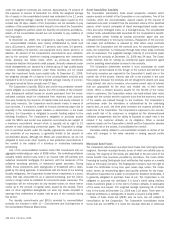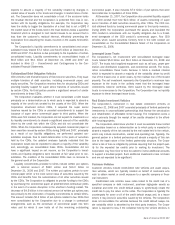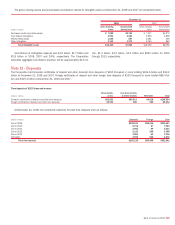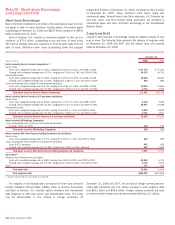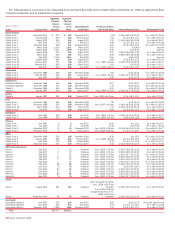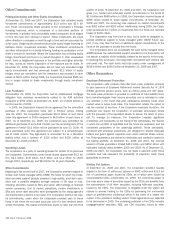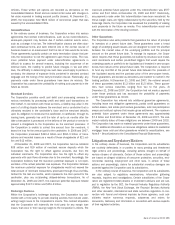Bank of America 2008 Annual Report Download - page 157
Download and view the complete annual report
Please find page 157 of the 2008 Bank of America annual report below. You can navigate through the pages in the report by either clicking on the pages listed below, or by using the keyword search tool below to find specific information within the annual report.vehicles. These written put options are recorded as derivatives on the
Consolidated Balance Sheet and are carried at fair value with changes in
fair value recorded in trading account profits (losses). At December 31,
2008, the Corporation held $323 million of commercial paper that was
issued by the unconsolidated CDOs.
Indemnifications
In the ordinary course of business, the Corporation enters into various
agreements that contain indemnifications, such as tax indemnifications,
whereupon payment may become due if certain external events occur,
such as a change in tax law. The indemnification clauses are often stan-
dard contractual terms and were entered into in the normal course of
business based on an assessment that the risk of loss would be remote.
These agreements typically contain an early termination clause that per-
mits the Corporation to exit the agreement upon these events. The max-
imum potential future payment under indemnification agreements is
difficult to assess for several reasons, including the occurrence of an
external event, the inability to predict future changes in tax and other
laws, the difficulty in determining how such laws would apply to parties in
contracts, the absence of exposure limits contained in standard contract
language and the timing of the early termination clause. Historically, any
payments made under these guarantees have been de minimis. The
Corporation has assessed the probability of making such payments in the
future as remote.
Merchant Services
The Corporation provides credit and debit card processing services to
various merchants by processing credit and debit card transactions on
their behalf. In connection with these services, a liability may arise in the
event of a billing dispute between the merchant and a cardholder that is
ultimately resolved in the cardholder’s favor and the merchant defaults
upon its obligation to reimburse the cardholder. A cardholder, through its
issuing bank, generally has until the later of up to six months after the
date a transaction is processed or the delivery of the product or service to
present a chargeback to the Corporation as the merchant processor. If
the Corporation is unable to collect this amount from the merchant, it
bears the loss for the amount paid to the cardholder. In 2008 and 2007,
the Corporation processed $369.4 billion and $361.9 billion of trans-
actions and recorded losses as a result of these chargebacks of $21 mil-
lion and $13 million.
At December 31, 2008 and 2007, the Corporation held as collateral
$38 million and $19 million of merchant escrow deposits which the
Corporation has the right to offset against amounts due from the
individual merchants. The Corporation also has the right to offset any
payments with cash flows otherwise due to the merchant. Accordingly, the
Corporation believes that the maximum potential exposure is not repre-
sentative of the actual potential loss exposure. The Corporation believes
the maximum potential exposure for chargebacks would not exceed the
total amount of merchant transactions processed through Visa and Mas-
terCard for the last six months, which represents the claim period for the
cardholder, plus any outstanding delayed-delivery transactions. As of
December 31, 2008 and 2007, the maximum potential exposure totaled
approximately $147.1 billion and $151.2 billion.
Brokerage Business
Within the Corporation’s brokerage business, the Corporation has con-
tracted with a third party to provide clearing services that include under-
writing margin loans to the Corporation’s clients. This contract stipulates
that the Corporation will indemnify the third party for any margin loan
losses that occur in their issuing margin to the Corporation’s clients. The
maximum potential future payment under this indemnification was $577
million and $1.0 billion at December 31, 2008 and 2007. Historically,
any payments made under this indemnification have been immaterial. As
these margin loans are highly collateralized by the securities held by the
brokerage clients, the Corporation has assessed the probability of making
such payments in the future as remote. This indemnification would end
with the termination of the clearing contract.
Other Guarantees
The Corporation also sells products that guarantee the return of principal
to investors at a preset future date. These guarantees cover a broad
range of underlying asset classes and are designed to cover the shortfall
between the market value of the underlying portfolio and the principal
amount on the preset future date. To manage its exposure, the Corpo-
ration requires that these guarantees be backed by structural and invest-
ment constraints and certain pre-defined triggers that would require the
underlying assets or portfolio to be liquidated and invested in zero-coupon
bonds that mature at the preset future date. The Corporation is required
to fund any shortfall at the preset future date between the proceeds of
the liquidated assets and the purchase price of the zero-coupon bonds.
These guarantees are booked as derivatives and marked to market in the
trading portfolio. At December 31, 2008 and 2007, the notional amount
of these guarantees totaled $1.3 billion and $1.5 billion. These guaran-
tees have various maturities ranging from two to five years. At
December 31, 2008 and 2007, the Corporation had not made a payment
under these products and has assessed the probability of payments
under these guarantees as remote.
The Corporation has entered into additional guarantee agreements,
including lease end obligation agreements, partial credit guarantees on
certain leases, real estate joint venture guarantees, sold risk participation
swaps and sold put options that require gross settlement. The maximum
potential future payment under these agreements was approximately
$7.3 billion and $4.8 billion at December 31, 2008 and 2007. The esti-
mated maturity dates of these obligations are between 2009 and 2033.
The Corporation has made no material payments under these guarantees.
For additional information on recourse obligations related to residential
mortgage loans sold and other guarantees related to securitizations, see
Note 8 – Securitizations to the Consolidated Financial Statements.
Litigation and Regulatory Matters
In the ordinary course of business, the Corporation and its subsidiaries
are routinely defendants in or parties to many pending and threatened
legal actions and proceedings, including actions brought on behalf of
various classes of claimants. Certain of these actions and proceedings
are based on alleged violations of consumer protection, securities, envi-
ronmental, banking, employment and other laws. In certain of these
actions and proceedings, claims for substantial monetary damages are
asserted against the Corporation and its subsidiaries.
In the ordinary course of business, the Corporation and its subsidiaries
are also subject to regulatory examinations, information gathering
requests, inquiries and investigations. Certain subsidiaries of the Corpo-
ration are registered broker/dealers or investment advisors and are sub-
ject to regulation by the SEC, the Financial Industry Regulatory Authority
(FINRA), the New York Stock Exchange, the Financial Services Authority
and other domestic, international and state securities regulators. In con-
nection with formal and informal inquiries by those agencies, such sub-
sidiaries receive numerous requests, subpoenas and orders for
documents, testimony and information in connection with various aspects
of their regulated activities.
Bank of America 2008
155



